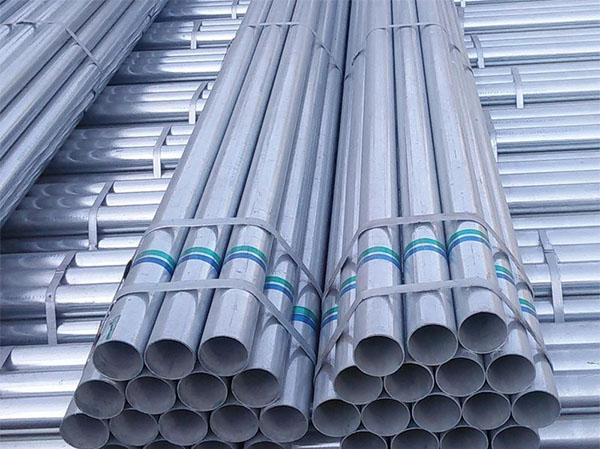galvanized carbon steel pipe refers to a steel pipe with carbon steel as the base material and a layer of zinc coated on its surface. This material combines the high strength of carbon steel with the anti-corrosion ability of zinc coating, so it is both strong and has good corrosion resistance.
carbon steel pipes themselves do not have protective capabilities. When exposed to moisture, air, salt spray or chemical media, rust will form on the metal surface due to oxidation reactions, resulting in corrosion that gradually weakens the strength of the steel pipe and shortens its service life.
To protect carbon steel pipes, common methods include painting, applying epoxy resin, and undergoing surface treatment with polyphosphate, etc. Although these measures can provide a certain degree of protection, the surface coating is prone to damage from scratches or peeling. Once the coating is damaged, frequent subsequent maintenance is required.

The protection mechanism of galvanized carbon steel pipes
Galvanizing refers to coating a layer of zinc on the surface of carbon steel pipes. It usually has a dual function:
Physical isolation: By covering the surface of the steel pipe with a zinc layer, it effectively blocks the intrusion of moisture, forming a strong and dense metal barrier.
2. Electrochemical protection: Carbon steel pipes are protected by the sacrificial anode cathodic protection method. Because zinc is more reactive than steel in terms of electrochemical potential, even if the zinc layer on the surface of the steel pipe is damaged, the surrounding zinc layer will still be corroded first, thereby protecting the exposed steel from oxidation.
The surface of galvanized carbon steel pipes can form a passivation film composed of zinc oxide and zinc carbonate. This film can further slow down the corrosion process, thereby enhancing the durability of the coating. Overall, the hot-dip galvanizing technology enables carbon steel pipes to have a protective life of up to 50 to 70 years or even longer under normal conditions.
The process and methods of galvanizing technology
Hot-Dip Galvanizing (HDG)
Process:
Pretreatment: Degreasing (cleaning with alkaline solution) → Rust removal (acid washing) → Phosphating or zinc-ammonium chloride plating assistance
Molten zinc: Immerse the steel pipe in a molten zinc bath at approximately 450°C
Cooling test: After taking out of the bath, cooling is carried out and the uniformity, adhesion and thickness of the coating are inspected
Characteristics and advantages:
The coating is thick and firm.
It has good wear resistance and weather resistance, is suitable for conventional outdoor environments, and has high cost-effectiveness.
The coating contains an iron-zinc alloy layer, which is bonded extremely firmly.
2. Electro-Galvanizing
Immerse the steel pipe in the electrolyte containing zinc ions and form a galvanized layer on the surface through electrochemical deposition technology.
This coating is relatively thin (usually only a few microns), with a smooth surface and luster. It is suitable for indoor environments and occasions with high requirements for appearance, but its strength is relatively low.
3. Hot diffusion galvanizing/Sherardizing
Also known as hot spray or dry diffusion treatment: Steel parts are sealed together with powder zinc and heated to approximately 500° C. Zinc vapor diffuses and forms a uniform coating.
It is suitable for galvanizing treatment of small parts or inner holes, with a uniform and consistent coating structure, but it is not suitable for mass production of pipes.
4. Galvanizing annealing treatment (Galvannealing)
After the hot-dip galvanizing process, annealing treatment is carried out to promote the diffusion reaction between zinc and steel through heating, thereby forming an iron-zinc alloy layer. The surface after this treatment presents a matte gray color, which not only enhances the welding performance but also provides convenience for the subsequent painting process.
5. Cold Galvanizing/Zinc-rich paint
It is an aluminum-zinc powder paint. A zinc layer is formed by spraying, which is used for repair after welding or as a temporary substitute, and can cover the damaged coating area.
Typical applications of galvanizing carbon steel pipes
Outdoor applications: such as water conservancy, gas pipeline networks, guardrails, railings, steel structure supports, etc.
Indoor piping systems: such as fire protection and water supply systems, but attention should be paid to the problem of water vapor corrosion in a closed environment.
Decorative or exposed pipelines: In occasions with strong decorative properties, electroplating or post-plating annealing treatment is commonly used.
